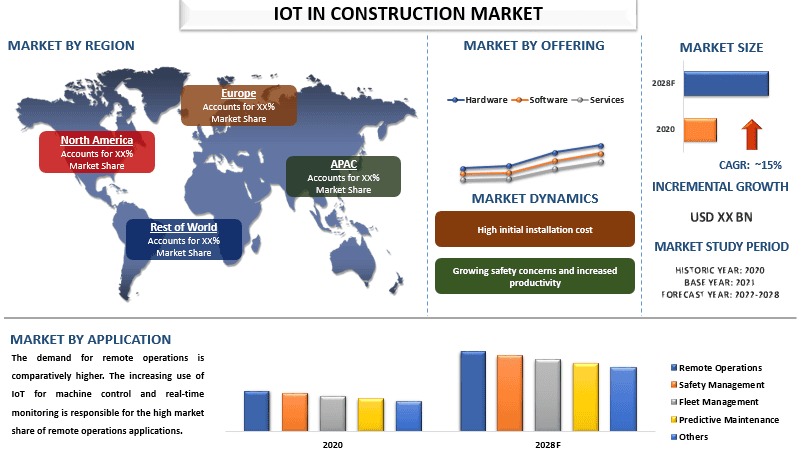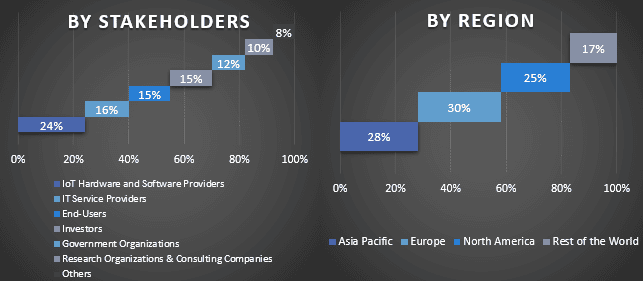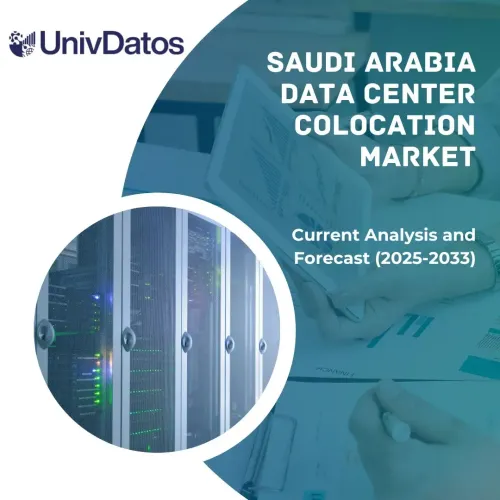- Home
- About Us
- Industry
- Services
- Reading
- Contact Us
IoT in Construction Market: Current Analysis and Forecast (2022-2028)
Emphasis on Offering (Hardware, Software, and Services); Application (Remote Operations, Safety Management, Fleet Management, Predictive Maintenance, and Others); Project Type (Commercial and Residential); and Region/Country

The global IoT in Construction Market is expected to grow at a growth rate of around 15% during the forecast period. The global IoT in construction market is growing on the account of the growing construction industry due to quick urbanization and increased productivity and safety due to the use of IoT in construction. IoT in construction refers to internet-connected devices and equipment used to maximize the effectiveness and efficiency of construction projects. IoT monitors supplies, workers, and equipment to save time and keep construction projects on track. Moreover, factors such as the ability of IoT to assist real-time business owners in tracking and generating a clear plan of complex budgeting in a single step, the growing use of smart technologies such as sensors, RFID tags, building information modeling, augmented reality, and the rising need for digital construction due to industry 4.0 are also influencing the growth of the IoT in construction market. Further, according to Eurostat, in 2021, 29 % of EU enterprises used Internet of Things devices, mostly for keeping their premises secure. Hence the IoT in construction market is expected to grow at a notable CAGR.
Some of the major players operating in the market include Caterpillar Inc., Oracle Corporation, Hitachi Ltd., CalAmp Corp., Autodesk Inc., Trimble Inc., Hexagon AB, Topcon Corporation, WakeCap Technologies, and KORE Group Holdings Inc. are some of the key players in the market. Several M&As along with partnerships have been undertaken by these players to facilitate customers with hi-tech and innovative products/technologies.
Insights Presented in the Report
“Amongst offering, software segment to witness robust CAGR during the forecast period”
Based on offering, the market is classified into hardware, software, and services. The software segment catered to a significant share of the IoT in construction market in 2020 mainly owing to the increased investment of the market player into the development of the software. Further, IoT software addresses key areas of connectivity and action through embedded systems, platforms, partner systems, and middleware. The increasing usage of analytics for better decision-making is further driving the growth of this segment.
“Amongst application, the remote operations segment to hold a significant share in the market in 2020”
Based on application, the market is divided into remote operations, safety management, fleet management, predictive maintenance, and others. The demand for remote operations is comparatively higher. The increasing use of IoT for machine control and real-time monitoring is responsible for the high market share of remote operations applications. Moreover, factors such as the remote use of IoT enables the delivery of data from connected products and other assets, reduces outages, enables wearable computing, enables operations, and reduces risk in hazardous environments are also helping the remote operations segment to grow.
“North America captured a significant share of the market in 2020”
North America captured a prominent share of the market in 2020. The high adoption of IoT in the construction industry by several original equipment manufacturers (OEMs) and the presence of major key players having their operation in IoT in construction market are some of the factors driving the market growth in North America. Moreover, increasing implementation of IoT technological advancements and rising construction projects are some of the other key factors driving the market growth in the region. Additionally, the region is seeing increased investment in infrastructure and construction projects, which is another factor contributing to the growing adoption of IoT in the construction industry in North America. For instance, according to the Construction Association of America, Construction is a major contributor to the U.S. economy. The industry has more than 745,000 employers with over 7.6 Mn employees and creates nearly USD 1.4 Tn worth of structures each year.
Reasons to buy this report:
- The study includes market sizing and forecasting analysis validated by authenticated key industry experts.
- The report presents a quick review of overall industry performance at one glance.
- The report covers an in-depth analysis of prominent industry peers with a primary focus on key business financials, product portfolios, expansion strategies, and recent developments.
- Detailed examination of drivers, restraints, key trends, and opportunities prevailing in the industry.
- The study comprehensively covers the market across different segments.
- Deep dive regional level analysis of the industry.
Customization Options:
The global IoT in construction market can further be customized as per the requirement or any other market segment. Besides this, UMI understands that you may have your own business needs, hence feel free to connect with us to get a report that completely suits your requirements.
Table of Content
Research Methodology for the IoT in Construction Market Analysis (2022-2028)
Analyzing the historical market, estimating the current market, and forecasting the future market of the global IoT in construction market were the three major steps undertaken to create and analyze the adoption of IoT in construction in major regions globally. Exhaustive secondary research was conducted to collect the historical market numbers and estimate the current market size. Secondly, to validate these insights, numerous findings and assumptions were taken into consideration. Moreover, exhaustive primary interviews were also conducted, with industry experts across the value chain of the global IoT in construction market. Post assumption and validation of market numbers through primary interviews, we employed a top-down/bottom-up approach to forecasting the complete market size. Thereafter, market breakdown and data triangulation methods were adopted to estimate and analyze the market size of segments and sub-segments of the industry pertains to. Detailed methodology is explained below:
Analysis of Historical Market Size
Step 1: In-Depth Study of Secondary Sources:
Detail secondary study was conducted to obtain the historical market size of the IoT in construction market through company internal sources such as annual reports & financial statements, performance presentations, press releases, etc., and external sources including journals, news & articles, government publications, competitor publications, sector reports, third-party database, and other credible publications.
Step 2: Market Segmentation:
After obtaining the historical market size of the IoT in construction market, we conducted a detailed secondary analysis to gather historical market insights and share for different segments & sub-segments for major regions. Major segments are included in the report as offering, application, and project type. Further country-level analyses were conducted to evaluate the overall adoption of testing models in that region.
Step 3: Factor Analysis:
After acquiring the historical market size of different segments and sub-segments, we conducted a detailed factor analysis to estimate the current market size of the IoT in construction market. Further, we conducted factor analysis using dependent and independent variables such as offering, application, and project type of IoT in construction. A thorough analysis was conducted for demand and supply-side scenarios considering top partnerships, mergers and acquisitions, business expansion, and product launches in the IoT in construction market sector across the globe.
Current Market Size Estimate & Forecast
Current Market Sizing: Based on actionable insights from the above 3 steps, we arrived at the current market size, key players in the global IoT in construction market, and market shares of the segments. All the required percentage shares split, and market breakdowns were determined using the above-mentioned secondary approach and were verified through primary interviews.
Estimation & Forecasting: For market estimation and forecast, weights were assigned to different factors including drivers & trends, restraints, and opportunities available for the stakeholders. After analyzing these factors, relevant forecasting techniques i.e., the top-down/bottom-up approach were applied to arrive at the market forecast for 2028 for different segments and sub-segments across the major markets globally. The research methodology adopted to estimate the market size encompasses:
- The industry’s market size, in terms of revenue (USD) and the adoption rate of the IoT in construction market across the major markets domestically
- All percentage shares, splits, and breakdowns of market segments and sub-segments
- Key players in the global IoT in construction market in terms of products offered. Also, the growth strategies adopted by these players to compete in the fast-growing market
Market Size and Share Validation
Primary Research: In-depth interviews were conducted with the Key Opinion Leaders (KOLs) including Top Level Executives (CXO/VPs, Sales Head, Marketing Head, Operational Head, Regional Head, Country Head, etc.) across major regions. Primary research findings were then summarized, and statistical analysis was performed to prove the stated hypothesis. Inputs from primary research were consolidated with secondary findings, hence turning information into actionable insights.
Split of Primary Participants in Different Regions

Market Engineering
The data triangulation technique was employed to complete the overall market estimation and to arrive at precise statistical numbers for each segment and sub-segment of the global IoT in construction market. data was split into several segments & sub-segments post studying various parameters and trends in the areas of the offering, application, and project type in the global IoT in construction market.
The main objective of the Global IoT in Construction Market Study
The current & future market trends of the global IoT in construction market were pinpointed in the study. Investors can gain strategic insights to base their discretion for investments on the qualitative and quantitative analysis performed in the study. Current and future market trends determined the overall attractiveness of the market at a regional level, providing a platform for the industrial participant to exploit the untapped market to benefit from a first-mover advantage. Other quantitative goals of the studies include:
- Analyze the current and forecast market size of the IoT in construction market in terms of value (USD). Also, analyze the current and forecast market size of different segments and sub-segments
- Segments in the study include areas of the offering, application, and project type
- Define and analysis of the regulatory framework for the IoT in construction industry
- Analyze the value chain involved with the presence of various intermediaries, along with analyzing customer and competitor behaviors of the industry
- Analyze the current and forecast market size of the IoT in construction market for the major region
- Major countries of regions studied in the report include Asia Pacific, Europe, North America, and the Rest of the World
- Company profiles of the IoT in construction market and the growth strategies adopted by the market players to sustain in the fast-growing market
- Deep dive regional level analysis of the industry
Related Reports
Customers who bought this item also bought










